Demographics Germany: Data for Your Analyses
WIGeoGIS provides companies that value up-to-date data for analysis with all the figures on demographics in Germany: residents, households, age structure, purchasing power, building information and much more!
How Has Germany's Demographics Developed?
Germany, the largest economy in Europe, is an attractive market for many companies. You can find out exactly what the demographic situation looks like using the market data from WIGeoGIS.
There are now 84 million people living in Germany. The German population has grown continuously since 1950, although the birth rate has been lower than the death rate for more than 50 years. The natural population decline was more than offset by immigration.
People in Germany are getting older on average. That said, there are some strong regional differences in the age distribution. The reason for this is the migration of young people from structurally weaker regions, which are mainly located in the new federal states.
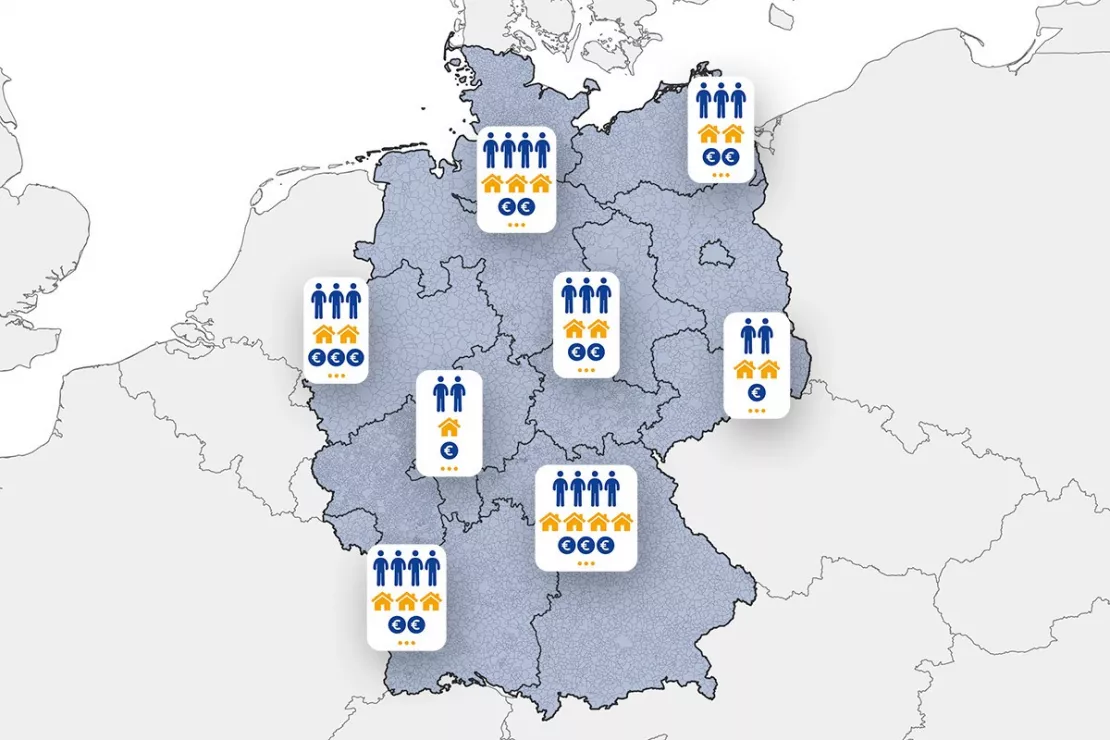
Demographics Germany: Data That Companies Need
- Population numbers
- Number of households
- Age structure and population groups
- Purchasing power of German households
- Building information
- Population forecasts for Germany
- Over 100 further demographic data points
Get exactly the data you need for your analyses.
Data on Demographics in Germany
WIGeoGIS has it!
Our demographic data for Germany is always up-to-date and as detailed as you need it, for example at the federal state, city, district, ZIP Code, grid and GEOmarket levels.
Let's take a look at the important data on Germany's demographics!
Test the demographic data for Germany for free with no obligation!
Which German state has the most inhabitants?
In first place is North Rhine-Westphalia, with around 18.1 million inhabitants, directly followed by Bavaria with around 13.3 million inhabitants.
In which city do most people live?
Unsurprisingly, Berlin is the clear winner here. The German capital has more than 3.7 million inhabitants.
In which municipality do the fewest people live?
Dierfeld in the Vulkaneifel is the smallest municipality in Germany with just 9 inhabitants. At the same time, Dierfeld also has the lowest population density with less than 6 people per square kilometer. In comparison, Munich is the most densely populated city with 4,800 inhabitants per square kilometer.
Which German federal state will have the strongest population growth in 2050?
The population in Berlin will increase by around 14% by 2050. No other federal state will grow as fast.
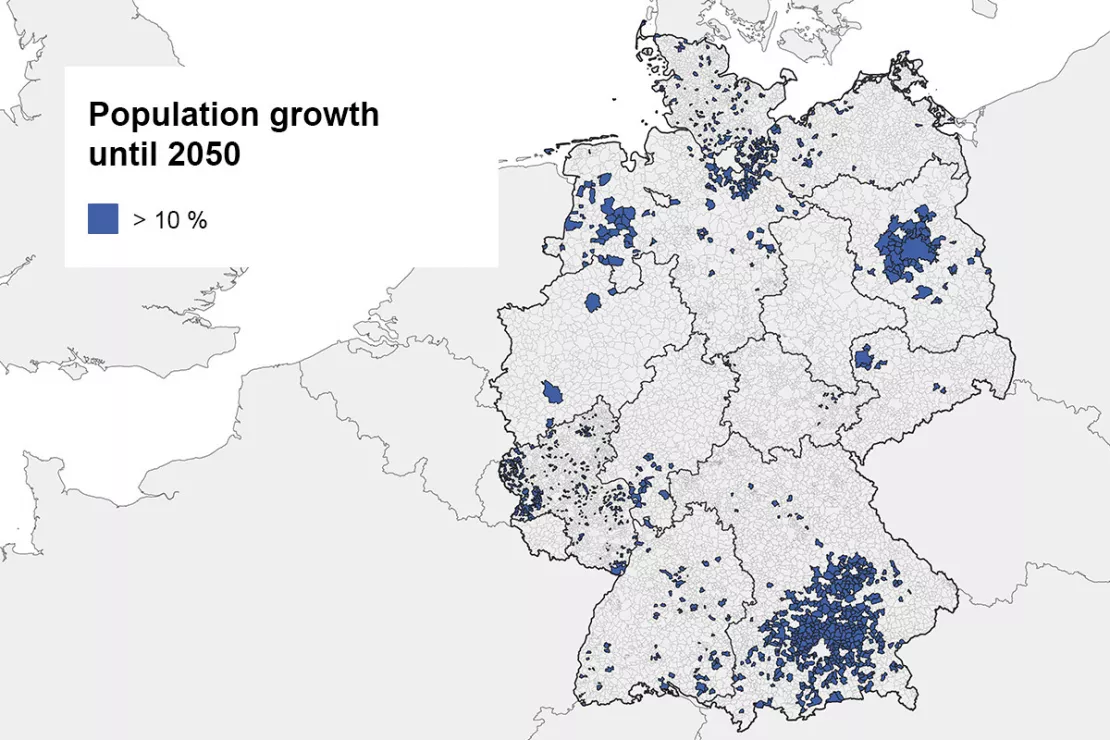
Where do the richest people in Germany live?
Bavaria is in first place with a purchasing power index of 108.2. Baden-Württemberg is in second place with a purchasing power index of 106.6, followed closely by Hamburg with 106.5.
Where is the most money spent on securities?
Per capita, around €61,000 is spent on securities in the North Frisian municipality of Witsum, and the second most with around €58,000 is spent in the Bavarian municipality of Grünwald.
Where is the purchasing power for organic food the highest?
In Germany, there is a strong east-west divide in organic purchasing power. In the new federal states, an average of only €158.5 per capita is spent on organic food, while it is €189.6 in the old federal states. Expenditure on organic food is highest in Baden-Württemberg, Hamburg and Schleswig-Holstein. The Schleswig-Holstein municipalities of Witsum (€316/capita) and Grothusenkoog (€315/capita) purchase the most organic food in Germany.
Where is the purchasing power for pet supplies the highest?
In Hamburg, an average of €85.3 is spent per capita on pet supplies each month, while Mecklenburg-Western Pomerania spends the least at €66.9 per capita.
Do it like the leading companies and analyze the German market using demographic data!
Where do more people commute in than out?
In Frankfurt am Main, more people commute in than out. Conversely, more people commute out of Offenbach than in.
In which federal state do most people rent and where do most people live in their own home?
With a share of 84%, most people in Berlin live in rented accommodations, while in Saarland, with a share of 69%, most people live in their own home.
Where are the highest home loans?
In the Schleswig-Holstein municipality of Aumühle and in the Bavarian Grünwald, around €59,100 in credit is given per capita.
In which German federal state do the most women live, and where do the most men live?
The gender distribution in all age groups is relatively balanced in the Federal Republic of Germany. Nevertheless, there are small differences. With a female share of 51.75%, North Rhine-Westphalia has the most women, while Hesse has the most men, with a share of 50.87%.
Interesting Facts About Germany
"Our data reveal a range of interesting facts about Germany's demographics. For instance, did you know that Nieby in Schleswig-Holstein is the oldest municipality in Germany with a senior citizen share of 62.6%? Or that the Schleswig-Holstein municipality of Grothusenkoog spends the most on flowers and gardening items in Germany, at €472 per capita?"
Doriana Meuthen, Manager, WIGeoGIS Munich

Where are the most small businesses in Germany?
Berlin has by far the most small businesses. After Berlin, cities like Hamburg and Munich are also particularly interesting for start-ups.
In which German municipality do most people work in the hospitality industry?
In the municipalities of Birx in Thuringia and Langscheid in Rhineland-Palatinate, 100% of the people work in the hospitality industry!
Which city is home to the most Germans paying social security contributions?
With a total of 1.5 million, Berlin is home to the largest number of employees who pay social security contributions in Germany. Hamburg follows in second place with around 800,000 people paying social security contributions.
Where do the most part-time self-employed people live in Germany?
In North Rhine-Westphalia there are around 232,000 self-employed people working part-time, closely followed by Bavaria with around 206,000.
Get Your Business off the Ground in Germany – Success Made Easier with Data on Germany's Demographics
Where do the most immigrants live in Germany?
Only 18 people live in the municipality of Keppeshausen in the southern Eifel on the border with Luxembourg, but approximately 72% of them are immigrants.
Where is the highest desk density in Germany?
First place in desk density goes to Schleswig-Holstein: In the municipality of Büttel there are 12,233.3 office spaces per 1,000 inhabitants.
Where do the most university graduates live and where do the most people who never finished secondary school live?
Most university graduates live in Germany's largest cities, namely Berlin, Munich and Hamburg. At the same time, this is also where the most people without a vocational qualification live. In Hamburg, there are more people who did not finish secondary school than there are university graduates, while in Berlin and Munich the number of university graduates is higher than the number of people who did not finish secondary school.
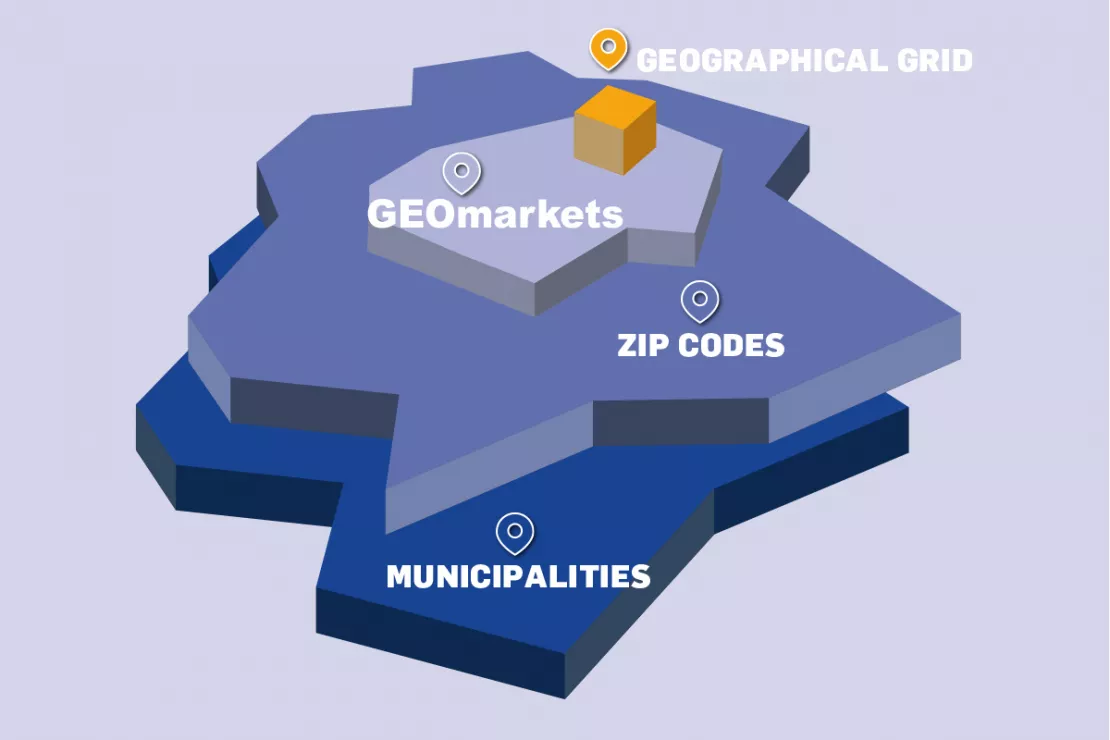
Market Data for Germany at the Following Levels
You decide how small-scale we deliver the data on demographics in Germany, for example at the level of
- Municipalities (average 7,490 inhabitants)
- ZIP Codes (average 10,160 inhabitants)
- GEOmarkets (average 440 inhabitants)
- Grid cells of different sizes, e.g. 250 x 250 m (average 67 inhabitants)
- or 100 x 100 m (average 22 inhabitants)
Analyze the German Market with the Demographics Data for Germany
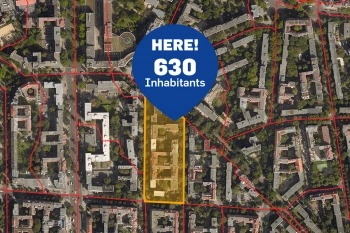
GEOmarkets: Regional Demographics for Germany
GEOmarkets are ideal for small-scale market analyses. They comprise an average of 300 households and take ZIP codes and municipal borders into account.
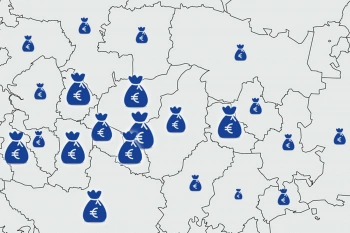
Purchasing power data - Knowing where people are consuming
Purchasing power data provides information about the level of prosperity and willingness to consume. We offer purchasing power data according to product and people groups at the ZIP Code level and smaller scales.
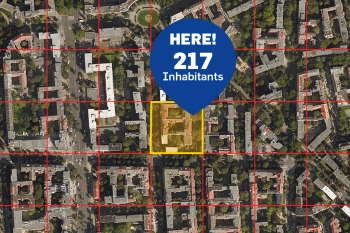
Regional Demographics in Geographic Grid Cells Germany
The AZ Germany-Raster includes regional market data for Germany in geographic grid - always equal areas of 100 x 100 m up to areas of 10 x 10 km.
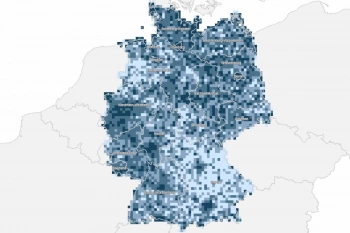
Data on Online Affinity and Online Purchasing Power
Data on internet usage are now essential. Retailers can use this data to localize target groups and estimate their market potential in online and brick and mortar retail.
Demography Germany - Test data free of charge and without obligation!
- Test data* on demographics in Germany
- Non-binding, free test
- Test ends automatically without cancellation
- Receive test data* as Excel or shape file
I will gladly support you, also by telephone.
* Information about the free test data: Selected test data for Germany is available for districts in Munich and the surrounding areas. The products of WIGeoGIS are intended for companies and are not suitable for private use. If you need a one-time market analysis, we will gladly make you a service offer.
FAQ
-
What is demographic data?
Demographic data is statistically collected data concerning the population of a country. It includes, among other things, population numbers, age distribution, level of education, birth rates, housing situation, family structure, income classes, migration, life phases, purchasing power of households, population development and forecasts.
-
Why do we need demographic data?
Companies often need demographic data for their planning, for example to find out where their target groups are, for example sporty, style-conscious people, educated parents or families with gardens. This data allows you to make strategically important decisions such as choosing a branch location, determining efficient marketing measures and optimally planning sales territories. Demographic data is particularly important when expanding into new countries or regions. Existing customers can also be analyzed using demographic data.
-
What is the benefit of displaying demographic data on a digital and interactive map?
Displaying the demographic data on a digital and interactive map such as WIGeoWeb or WIGeoStandort has decisive advantages over lists and tables. A glance at the map is enough to gain an overview of important factors such as age distribution, purchasing power, housing situation and even specific information such as pet supplies, consumption of organic food and commuting behavior in a region or country.
Internal company data such as locations, sales and customer data can also be integrated into a digital map and linked to demographic data, for example, areas with the highest potential can be identified immediately without studying long lists.
-
What are GEOmarkets?
GEOmarkets are small-scale market and geodata for sales, marketing and location planning. With this data, you can not only look at facts at the federal state, county or municipal level, but also analyze market conditions on a smaller scale.
-
What makes GEOmarkets special?
- A GEOmarket contains on average 300 households
- There is comprehensive information on all 22.5 million inhabited buildings in Germany
- More than 100 characteristics are available
- The area statuses are updated annually, with Germany currently consisting of around 160,000 GEOmarkets
- GEOmarkets run along streets and natural borders such as rivers and railway lines and are thus oriented towards human (e.g. shopping) behavior
- The data comes from various sources such as public directory data, high-quality anonymized address sources, surveys, the analysis of aerial photographs and official statistics
- All data is anonymous and compliant with data protection laws making it impossible to draw conclusions about any individuals
-
What do the public sector and public administration use demographic data for?
The public sector and public administration need demographic data, particularly for infrastructure and supply planning. For example, it is important to build roads, residential and office buildings in areas where a corresponding number of people live and would also use these services. The same applies to other infrastructure areas such as energy supply, waste disposal and sewage treatment plants. Demographic data thus helps avoid bad investments and provide infrastructure and services exactly where they are needed.
-
How does demographic data help with needs analyses?
Before making major investments, not only companies, but also public institutions such as authorities and administrative organizations, must carry out needs analyses, for example:
- How big should the new hospital be?
- How many doctors are needed there?
- How many classes does the new school building need?
- How many people will use the new train station?
In order to carry out such needs analyses in the public sector and thus make the right investment decisions, demographic data is absolutely necessary. WIGeoGIS is happy to support you.

